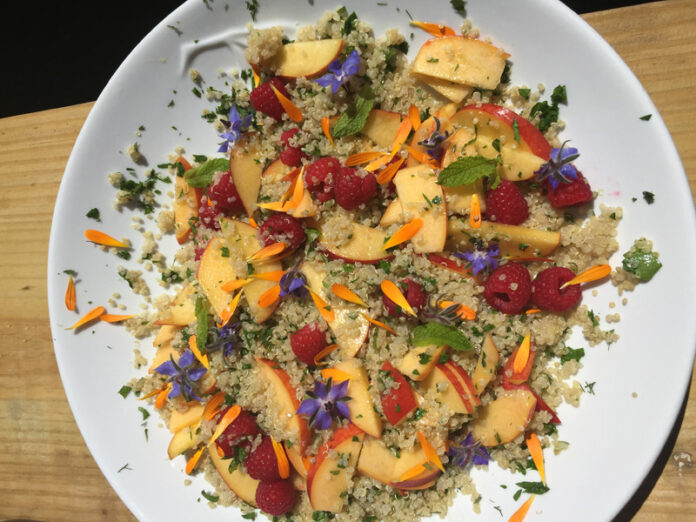“This is my invariable advice to people: Learn how to cook — try new recipes, learn from your mistakes, be fearless, and above all — have fun.” —Julia Child
In the spirit of Julia Child and having fun in the kitchen, learning about edible flowers can bring art, beauty, and whimsy to your cooking time.
While not all flowers are edible, like daffodils or buttercups, many are perfectly fine to eat and use. It’s still not that easy to find edible flowers in supermarkets, so growing them or looking around your surroundings is probably the best way to start. (See below for one great source of local edible bouquets.) Each Island spring you can find dainty violets hiding in your untreated grass, white and pink roses blooming along beach roads, and yellow mustard flowers among wild spring greens — all tasty. Summer, however, is the prime time for edible flowers, even though you find some real beauties in the fall, including pineapple sage, which blooms with elongated scarlet flowers through October. The pineapple sage flowers taste sweet and fruity, with a hint of mint and the scent of pineapple when crushed.
When you discover and start using edible flowers, you gain an additional tool in the kitchen. Dashes of purples, yellows, pinks, and oranges — the palette of edible flowers makes food and drinks look even more appealing as they leave your kitchen. Sometimes a whole flower works best, maybe a red-orange nasturtium topping a salad or floating in a punch.
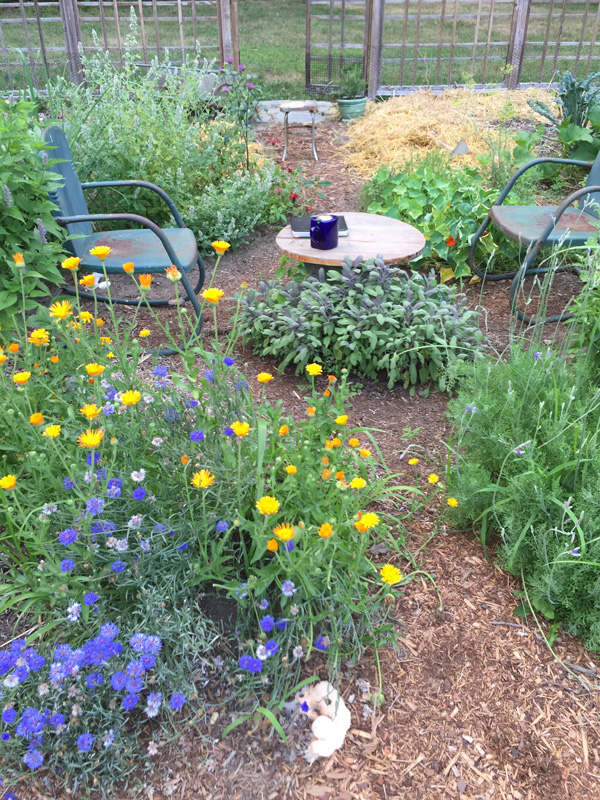
My eyes opened to edible flowers the year I planted an experimental section of medicinal herbs, not far from the culinary herbs like parsley and basil. I learned that quite a few of the medicinal herbs — like borage, calendula, and echinacea — bloom all summer with edible flowers and this became the prettiest section. I also learned how useful they could be. The daisy-like orange and yellow calendula flowers made their appearance in almost everything, from salads to yogurt parfaits to weekend crepes. The borage flower, with its star shape and bluish-purple leaves, became a favorite. It tastes like cucumber, and has been around since ancient times, said to impart courage and trigger positive thoughts. I popped one in my mouth each time I walked by. I’m just beginning to learn about medicinal uses for both flowers and leaves. Echinacea flowers, or coneflowers, have been used in both traditional and folk medicine for centuries, often brewed in teas. Pineapple sage flowers are said to have antidepressant and anti-anxiety properties.
“Many edible flowers are nutritional and medicinal powerhouses,” says Rebecca Gilbert of Native Earth Teaching Farm in Chilmark. When she wrote her book “Weedy Wisdom for the Curious Forager,” published last year, she included a whole chapter called Eating Flowers. Along with recipes for candied flowers or making tea blends with flowers, she suggests floating edible flowers in hot or cold soups, flavoring butter cookies and cakes, freezing in ice cubes or adding to butters, jams, honeys, and sugars. “They always seem like a special kind of gift,” she says. “And they make such a dramatic statement, they can really make a forager shine!”
Gilbert reminds us not to overlook the garden plants that produce their own edible flowers, like thyme, cilantro, and dill, as well as squash, arugula, kale, and beans. The orange flowers from scarlet runner beans are among her favorites, and those might look great with a plate of tomatoes. The “side effect is that you don’t have to plant anything special,” says Gilbert. The edible dill blossoms come in wispy, wide-spreading formations called “umbels” with tiny golden yellow petals that look nice on food platters.
This season, Gilbert is trying a new Asian flowering herb called “Tong Hao.” She bought seeds from Second Generation, a seed company that specializes in heirloom Asian plants. It describes Tong Hao as a type of chrysanthemum, having “a big, bright, fresh herby flavor, with a crunchy, juicy stem that makes it the highlight of any hot pot.”
While some flowers have interesting flavors like pineapple and cucumber, many taste sweet for the pollinator bees they are meant to attract. Still others are spicy or reminiscent of the herb or plant itself, like arugula or kale flowers. It’s helpful to taste each variety and get to know the flavors yourself — you may not want to use a garlicky chive blossom on a dessert or a pungent white cilantro flower in your iced tea. And invite your guests to sample and enjoy the edible flowers; people don’t often know they can.
When you pick flowers, check for any insects feeding inside the flower, but avoid rinsing or soaking. Most are too delicate for this step. If not using immediately, keep chilled in the fridge until ready to use.

Edible bouquets
If you can’t grow or forage for flowers, a great way to experiment this summer is to sample the edible bouquets available for sale at North Tisbury Farm Market on State Road in West Tisbury. Owner Rose Willett says the sampler bouquets sell for $10 and might include zinnias, a variety of cosmos that’s edible, sweet alyssum, Johnny jump-ups, bachelor buttons, nasturtiums, and other edible flowers as they bloom in the garden out back.
“It’s something I’ve been trying to get people interested in for a number of years; I’d put them out and nothing would happen,” says Willett, who started using flowers along with herbs more than a decade ago to decorate cheese and charcuterie platters. “I just didn’t give up and last year it really took off, which was great.” A Johnny jump-up or borage flower, for example, she says looks beautiful on a triple cream cheese. Willett says the market plans to dry flowers this year and create blends to sell, as well as making compound butters, salt mixes, and cakes decorated with flowers. Willett says the dried flowers keep their colors and look great on desserts as well as savory dishes like halibut or sole.
Kitchen uses
If you are having a party, do what I did as a caterer and head to the garden to pick a bowlful of green herbs and edible flowers to have on hand. They always get used and every dish looks a little more artistic. In my own kitchen, even though there’s a garden out back, I like to fill two or three tiny vases with various bouquets of herbs and flowers, and put them on the counter. They not only look and smell great, but it keeps me from running out to the garden constantly and allows me to experiment daily. Recently, I was adding flowering thyme sprigs to drinks and using the abundant winter savory in every dish I could, trying to figure out where it tastes best.
My favorite use for flowers seems to be summer drinks like iced tea and lemonade — and any and all cocktails. Mixing and matching flowers and herbs together such as sprigs of thyme and flowering anise hyssop — really any green and any flower — always looks appealing. You can also make ice cubes for summer drinks by mixing different flower petals and herbs and when frozen, popping them into ziplock bags ready for use. Pretty much any and all salads look better with a few flowers or flower petals.
Adding flowers to enhance desserts, the finale, is a natural. Top cupcakes with a beautiful edible flower, or mix in with any dessert featuring berries and whipped cream, like shortcakes or pavlova.
So grow or forage for some edible flowers, think of Julia Child, and channel your inner artist.
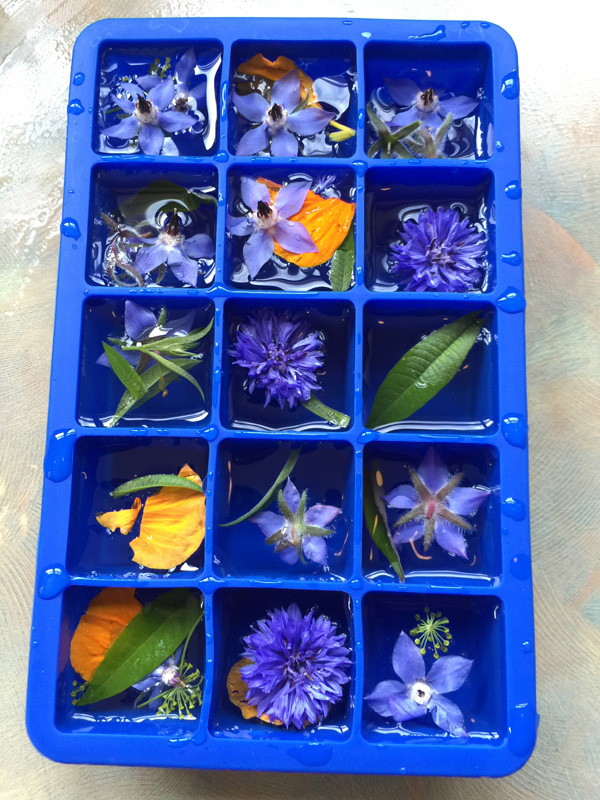
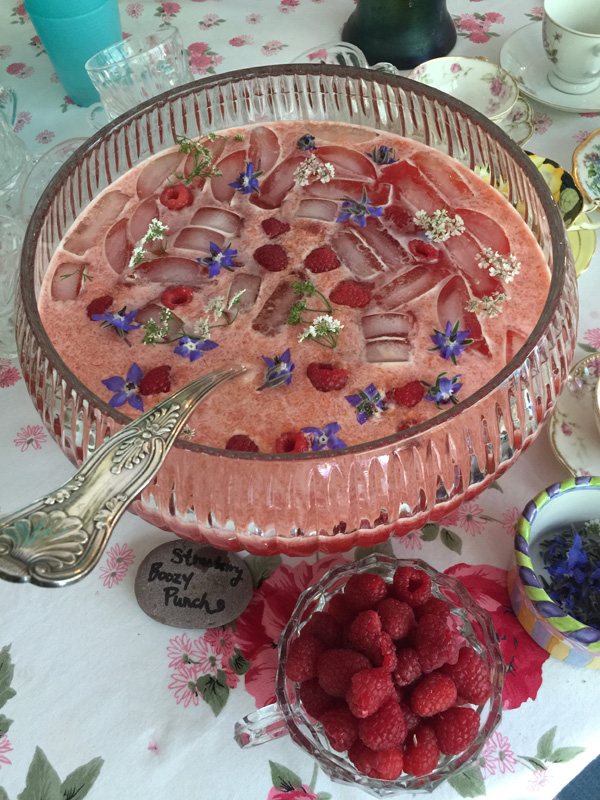
Partial List of Edible Flowers
From Rebecca Gilbert’s “Weedy Wisdom for the Curious Forager, Common Wild Plants to Nourish Your Body & Soul.”
Anise hyssop Apple blossom (in moderation) Arugula Basil Bachelor’s buttons Bergamot Black locust Borage Calendula Carrot Catnip Chamomile Chickweed Chicory Chrysanthemum Citrus blossom Clover (in moderation) Coriander Dahlia Daisy
Dandelion Dayflower Daylily Dill Elderflower (no stems) Evening primrose Fennel Garlic mustard Gem marigold Geranium (scented) Gladiola Goldenrod Hibiscus Hollyhock Hyssop Jasmine Johnny jump-up Lavender Lilac Linden
Mint Mullein Mustard Myrtle (in moderation) Nasturtium Okra Oregano Pansy Pear blossom (in moderation) Primrose Radish Rosemary Rose Sage Snapdragon Thyme Tulip Turnip Violet Yarrow
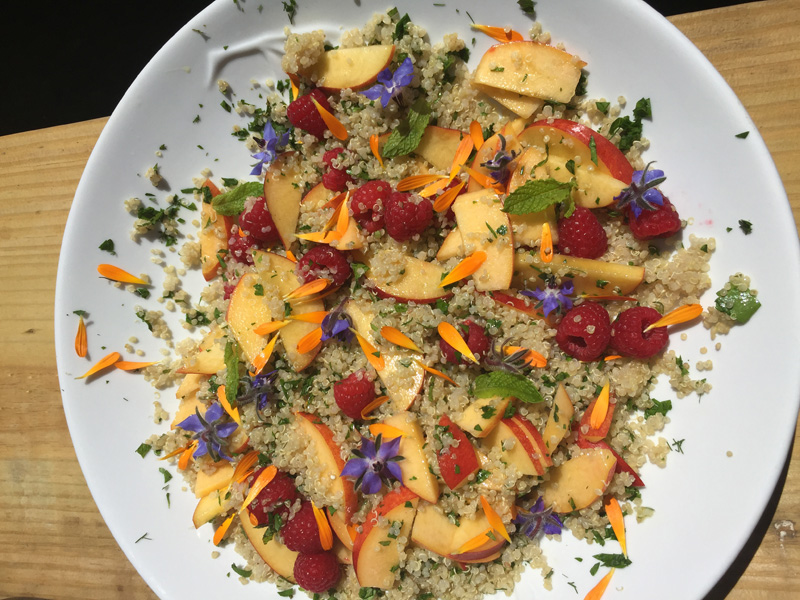
Quinoa Salad with Peaches and Flowers
Serves 8 as a side
This colorful salad is a good side for the summer table with everything or for a brunch. The key to cooking quinoa just right for salads (not mushy) is to use less than 2 cups of water for every 1 cup of quinoa. I usually aim for 1 2/3 cups of water. Chopped mint is also a nice addition, along with the parsley.
1 cup quinoa 1 ⅔ cups water Salt 1 cucumber, peeled, quartered lengthwise and cut into thin triangles 1/2 cup microgreens, baby kale, or finely chopped parsley 1 cup raspberries, rinsed and dried (or substitute blueberries or halved cherries) 2 peaches, peeled and sliced (or nectarines, which don’t need peeling) Edible flower petals for garnish (calendula petals and borage are shown above)
Dressing
2 Tbsp. lemon juice 3 Tbsp. fresh orange juice 2 tsp. raw honey or maple syrup 2 tsp. minced shallot 3 Tbsp. olive oil 2 good pinches of salt
Add quinoa, 1/4 tsp. salt and 1 2/3 cup water to a saucepan. Bring to a boil and then reduce heat to low, cover, and cook for 12-13 minutes, until the water is absorbed. Turn off the heat and let the quinoa sit for 5 minutes. Remove the cover and set aside to cool completely.
Combine the cooled quinoa with cucumber and greens.
Make the dressing in a small bowl by whisking together the lemon juice, orange juice, olive oil, honey or maple syrup, shallot, and salt. When ready to serve, add to the quinoa and vegetables and toss gently to combine. If you dress only what you are eating that day, the salad will keep nicely for a few days.
Gently fold in the peaches and raspberries. Garnish with edible flowers.
















